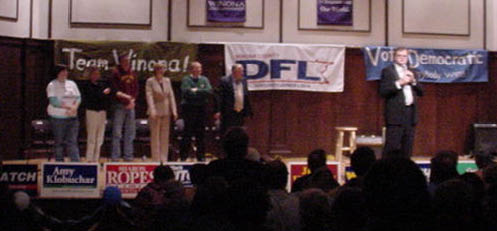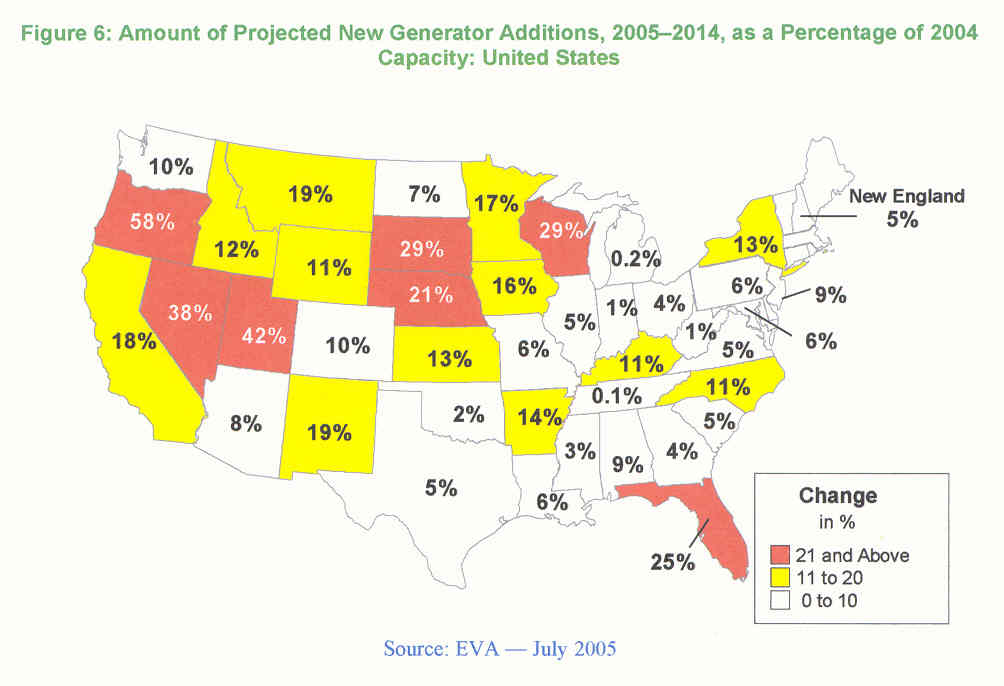Republican operatives in Wetterling’s campaign?
October 18th, 2006
.

(I’m buried in reams of Prefiled Direct and Rebuttal testimony, got two notebooks in the mail and then some. If it’s thought provoking reading that you want, scroll down and check out testimony of Xcel, Commerce, Chamber, Minnesota Power and of course mncoalgasplant.com!)
This Wetterling “scandal” caught my attention. You know, the Democrats do really stupid things sometimes, we’ve seen that this year, last year, year before — yeah, I remember way too many campaign seasons — but this is just too stupid to believe it’s a DFL blunder. When a candidate is riding an unexpected wave of “right person-right place-right time” notariety, you just don’t DO things like this, I mean, it’s not like Rowley’s guy going to Kline HQ.
Supposedly a field organizer sent Bachman staff an email:
“I have not had a chance to volunteer yet this year but I see we are trailing in the latest poll,” the e-mail read. “Is there a plan to get us back ahead? We need to win this race and keep power in the house. Thanks, Erick.”
And Bachman is on it right away, saying that they’re trying to “gain access to our campaign and our campaign strategy.”
Oh, right, Michelle, someone emails out of the blue and you give them access to the campaign and campaign strategy? I don’t think so. And at a time when Bachman is down, perhaps down for the count, she’s now got something to get all Republican Righteous about and get some press. Sure… let’s create a circus!
What’s this about? I decided to check with Erick!
Yes, Erick the Infamous, Rice Co. DFL Chair, reviled by DLFers and Repugnants alike, writer, reporter, errrr… FORMER reporter… Anyway, given the odd spelling Wetterling’s F.O. used, most know it’s “Eric” or “Erik”, well, the Erick the Expert says, “There are a few others out there with the funky spelling; they’re mostly of Persian descent or African-American. ”
So what’s that field organizer up to? It’s a decidedly weird choice of a name to use! An unlikely co-incidence? Someone who thinks Erick needs help getting into trouble with the DFL? A Republican plant in the Wetterling campaign?
And then there’s this: Republicans protest trashy politics
Inquiring minds want to know… I sense a conspiracy…
WAIT, WHO DID I JUST SEND THIS TO???
A Wetterling campaign worker is fired over e-mail
The campaign manager for DFLer Patty Wetterling fired a field organizer Tuesday after Republican Michele Bachmann alleged a “dirty trick” in the Sixth Congressional District campaign.Bachmann said one of her field staffers received an e-mail Monday from a volunteer named “Erick.” But the e-mail heading indicated the message was from “Jon Bohn,” a Wetterling employee who joined the campaign about a month ago.
“I have not had a chance to volunteer yet this year but I see we are trailing in the latest poll,” the e-mail read. “Is there a plan to get us back ahead? We need to win this race and keep power in the house. Thanks, Erick.”
In a letter to Wetterling, Bachmann said it appeared Bohn was “attempting to gain access to our campaign and our campaign strategy.”
Wetterling campaign manager Corey Day said he confronted Bohn, 22, a field organizer with the campaign. Bohn acknowledged sending the e-mail and Day fired Bohn on the spot on Tuesday.
“Once he told me he sent it and I saw the e-mail, he’s no longer part of the organization,” said Day.
Day said that as far as he knew, the one e-mail was the only thing Bohn had done that was inappropriate and no one else in the Wetterling campaign was involved.
In her letter to Wetterling, Bachmann said it may be illegal to try to try to gain access to an opponent’s campaign using a false identity. She said she was referring the matter to state and federal authorities.
“Campaigns can be tough,” Bachmann’s letter said. “But playing dirty tricks has no place in Minnesota politics.”
ERIC BLACK AND THE ASSOCIATED PRESS
Last night’s rally in Winona
October 17th, 2006

Last night’s rally in Winona was great — packed house, lots of energy, it feels secure — it feels like taking most of Southern Minnesota, the Senate seat and the Gov’s office is within reach or even, dare I say it, a happen’ thang! This gathering had the most real, and least delusional feel of any I’ve been to, due in large part to Tim Walz, a solid regular guy who is giving Gutknecht a run for his money and who can win. Polls say they’re in a dead heat, so give him a few more days and he’ll tip the scales.
Here’s the story in the Winona paper:
And Czechomor — www.czechomor.com
I’ve got these unknown and haunting hook lines floating around in my brain’s tape loop. Don’t read the liner notes though, yes, much is in quirkily percussive minor keys so there is fair warning, but you don’t need to know what it all means, that’s just too much depressing sturm & drang!

Annual NERC Reliability Assessment is out
October 16th, 2006

OH, NOOOOOOOOO, WE’RE GOING TO FREEZE IN THE DARK ON A RESPIRATOR WITHOUT A JOB!!!!!!
That’s “Utility Panic Propaganda Piece WGTFITDOARWAJ” and we’ve heard it before… sigh…But our electrical grid is not broken the way they’d like us to believe, yet it’s assuredly cracked and can’t be fixed. That is, it can’t be fixed with more transmission and more central-station generation! But we can indeed fix it in a way we can live with. It’s our job to do that. But folks, you have to actually look at the report, read it, CAREFULLY, and take in what it says, and note what is missing (hint: new generation).
The NERC 2006 Long-Term Reliability Assessment is out, the report that comes out this time every year. Light years ago, up in Duluth on a transmission case, an engineer in the know handed me a copy of the NERC 1999 Long-Term Reliability Assessment as if it were the Holy Grail, “Here, you need this,” and I took that very seriously and read it. Since then, I’ve used each years’ version, entered it in every proceeding, every time I testify about whatever, because this industry report shows that we do not need electricity the way utilities would have us believe. So what does that mean? What am I basing that on?
Check this map about new generation:

Note the 17% for Minnesota, and 39% for Wisconsin. The capacity margins for MRO (which we know affectionately as MAPP) are way more than adequate, sometimes twice over. The 2005 report states specifically:
Energy
The MRO tracks annual electricity use by both region and subregion:
â?¢ Annual electricity usage for the entire MRO region in 2004 (195,528 GWh) was 0.6% above 2003 consumption (194,286 GWh) and 3.0% below the 2004 forecast (201,605 GWh).
â?¢ Annual electricity usage for MRO-U.S. in 2004 (154,053 GWh) was 1.1% above 2003 consumption (152,310 GWh) and 3.7% below the 2004 forecast (159,932 GWh).
â?¢ Annual electricity usage for MRO-Canada in 2004 (41,475 GWh) was 2.7% above 2003 consumption (40,369 GWh) and 0.5% below the 2004 forecast (41,673 GWh).
2005 NERC Long-Term Reliability Assessment, p. 57. Go figure, for some odd reason, in the 2006 NERC report, they do not include that graphic little map, nor do they address the overstatement of utility “need” as specifically or accessibly as they do above. There is not one reference to the MISO queue which has so many thousands of megawatts of generation at various stages of development waiting in line to be interconnected. To find the real poop, you’ve got to really be looking for it. And when it’s hard to find, having to read between the lines, why, we end up with articles like this in the NY Times, and if it’s in the times, it has to be true, eh? GRRRRRR Let’s see, how can we interpret overestimation of need and how can we fail to consider and include thousands of megawatts of new generation? Here’s what happens when a non-critical reader and writer lets loose — what we get is a creative take on it that distorts the reality of our secure and reliable grid, one meant to generate fear rather than convey the content of the report:
By MATTHEW L. WALD
WASHINGTON, Oct. 15 â?? Companies are not building power plants and power lines fast enough to meet growing demand, according to a group recently assigned by the federal government to assure proper operation of the power grid.
The group, the North American Electric Reliability Council, in its annual report, to be released Monday, said the amount of power that could be generated or transmitted would drop below the target levels meant to ensure reliability on peak days in Texas, New England, the Mid-Atlantic area and the Midwest during the next two to three years.
The council was established in 1965 after a blackout across the Northeast, and has since set voluntary standards for the industry. After the blackout of 2003, which covered a vast swath of the Midwest, Northeast and Ontario, Congress set up a process that would eventually give the council the authority to fine American companies that did not follow certain operating standards. It is seeking a similar designation in Canada, since â?? electrically speaking â?? the border is irrelevant.
For years, the council has produced often-gloomy annual reports, but this is the first to be officially filed with federal agencies, and to recommend specific action.
The report says, for example, that utilities should be encouraged to pursue financial incentives for customers to cut use during peak hours, thereby lowering demand for new power plants and transmission lines. Financial incentives could reward customersâ?? installation of more efficient equipment or, more drastically, reward a factory for closing on a day when electricity supplies are expected to be tight.
The president of the council, Rick P. Sergel, said in a telephone interview, â??The situation has existed for a long time, but we cannot let it continue.â?
Planning for adequate capacity has become more difficult with the restructuring of the electric industry. Where a handful of top-to-bottom companies once generated power, transmitted it and delivered it, hundreds of companies are now involved in only one or two phases of the process. At the same time, getting permits to build new power lines has become more difficult.
The actual balance between supply and demand depends in part on changes in technology. Grid operators can now push more power through existing lines, plant operators have found ways to make generators more reliable and sharp increases in the efficiency of how electricity is used could slow demand.
The report predicts that demand will increase by about 19 percent over the next 10 years in the United States, and slightly less in Canada, and that the construction of power plants and transmission lines to carry that load will fall far short of what is needed. In this country, utilities have contracts with new power plants for only about a third of the capacity that will be needed; in Canada, the number is about two-thirds.
The number of miles of transmission lines, which can help redistribute supplies, will increase by only about 7 percent, the report said.
We need to tell Mr. Micheletti that he can go home…
October 16th, 2006
.
… to Minnetonka, that is…
Great letters in the Grand Rapids Herald Review:
Mesaba Energy Project is not the answer
Herald-ReviewEditor:
Is the Mesaba Energy Project the answer?
Promotors of the Mesaba Energy Project say that with newer and cleaner technology, the proposed new power plants would do less damage to the earths ground, water and air, and to health than traditional power plants. Is doing less damage the answer to meeting the energy needs of the future?
All additional emmissions would be cumulative and would continue to worsen our already threatened quality of life and longevity, not just for this generation but for the next 10, 100 and 1,000 generations, should the human race continue to survive. Shouldn’t we care?
As a mobile and enterprising civilization, of course we need energy. Acquiring that energy by depleting the earths finite resources to the detriment of the earth itself and life on earth is not the answer.
The long term answer to meeting the energy needs of people can only be met through the harnessing of renewable energy sources.
Minnesota is a national leader in such areas as technology and medicine. Yet, as a state and country the United States ranks near last of the developed nations in planning for the energy needs of the future.
How do we proceed? First, our state must have a clear energy policy so that our greatest resource, Minnesota people, have direction. We have the opportunity to lead the nation in clean energy technology development and production. And, a dedicated renewable energy industry would create a full array of job opportunities for Minnesota.
We need to convince our elected leaders that we are serious about safe energy. All of our elected leaders, regardless of political affilliation, need to be fully committed and we need to help.
We need to tell Mr. Micheletti now that he can go home because we have no interest in seeing hundreds of millions of dollars squandered for a destructive and already obsolete power plant. We have a better idea. All new energy investment must go toward energy development and production that is friendly to sustaining life. We can and must do this.
Jack Pick
Goodland
…and another!
Project would bring more pollution
Herald-Review
Editor:
On Sept. 24, Peter McDermott of the Itasca Economic Development Corporation wrote an article in the Herald Review touting the Mesaba Project. He stated that the area has had both heavy industry and tourism as its economic base. This has been true, but this is a mistake to support this experimental coal burning plant.
Resort owners, others dependent on tourism, those who have moved here for the clean environment, and most of us who enjoy fishing, hunting, and gardening, should be aware that Excelsior Energy supporters are turning their backs on the environment to steer the area in a heavy industry direction.
We have fish consumption advisories on nearly all Itasca County lakes. If any more methyl mercury is added to our ecological system, I think postings at boat landings would be appropriate. Resort owners had better advise their clients of the danger and the general public should be aware of the health risks involved with fish consumption.
Cumulative effects of this plant, the new steel mill, existing Clay Boswell plant and six taconite plants are all heavy contributors to the mercury levels. If we add the other two proposed Excelsior energy plants, with all these smokestacks, we may as well live in Pittsburgh.
The IEDC is taking the same route the Range has taken for many years. I believe we need forward thinking people in these positions. Remember the chopsticks factory in Hibbing, the fish farm in Chisholm, Endotronics, Tire cycle, the recycle plant outside of Keewatin to produce pellets out of junk cars, and the list goes on.
This plant will make money for Excelsior Energy big shots, real estate speculators, bars and other businesses that will cater to the construction workers. They will come here, make their money and leave. We will be left with run-down trailer parks which will soon fill with more low income people living on county assistance. All this for 100 jobs that probably will not employ local people. These jobs require engineering and technical skills. These are skills that our local unemployed 30-year- old high school graduates just don’t have. One must be responsible for one’s own financial betterment. This means getting an education and working where there is a need for that selected field. The technology for this project is far from perfected. The power generated will not be used here but transmitted on newly constructed power lines through local wetlands and farms and out of our area. Mesaba and its supporters want us to believe it’s the patriotic thing to do. Destroying our lakes and air for profit is not patriotic.
A healthy environment is the best gift we can give to future generations. Everyone must remember that this project started out as 1000 jobs at the site of the old LTV plant in Hoyt Lakes. Now it has dwindled to 100 jobs in the lakes area of Itasca County. This is the ultimate bait and switch and our public leaders fell for it.
Frank Weber
Nashwauk
Mesaba Testimony – Intervenors Rebuttal
October 15th, 2006
I’d posted the Rebuttal Testimony of mncoalgasplant.com a while ago. It’s at:
mncoalgasplant.com’s Rebuttal Testimony
And now for everyone else’s:
Dept. of Commerce
05-1993-pub-rebuttal.pdfMinnesota Power
hodnik-rebut-tstmy-10-10-06.pdfMinnesota Chamber of Commerce
mcc-blazar-reply-testimony.pdfXcel
reed-rubuttal.pdf
hyde-rebuttal.pdf
schiro-rebuttal.pdfExcelsior (some exhibits too large to post)
bodmer-public-rebuttal-testimony.pdf
exhibit-ecb-2.pdf
cavicchi-rebuttal-testimony.pdf
j-chen-rebuttal-testimony.pdf
exhibit-__-ajc-1-10-10-06.pdf
exhibits_ajc-2-to-ajc-6.pdf
d-cortez-public-rebuttal-testimony.pdf
dc-1-public-cv.pdf
dc-6-addendum-b-public.pdf
dc-7-public-fluor-report.pdf
b-evans-rebuttal-testimony.pdf
r-gale-rebuttal-testimony.pdf
exhibit-rwg-1.pdf
exhibit-rwg-2.pdf
exhibit-rwg-3.pdf
exhibit-rwg-4.pdf
exhibit-rwg-5.pdf
exhibit-rwg-6.pdf
exhibit-rwg-7.pdf
exhibit-rwg-8.pdf
hamilton-rebuttal-testimony.pdf
b-jones-rebuttal-testimony.pdf
t-lynch-rebuttal-testimony.pdf
m-meal-public-rebuttal-testimony.pdf
exhibits-meal-final-10-09-06-wpublic-mam-7.pdf
r-olson-rebuttal-testimony.pdf
exhibit-ro-1.pdf
exhibit-ro-2.pdf
exhibit-ro-3.pdf
exhibit-ro-4.pdf
exhibit-ro-5.pdf
exhibit-ro-6.pdf
t-osteraas-rebuttal-testimony.pdf
exhibit-tlo-1.pdf
exhibit-tlo-2.pdf
exhibit-tlo-3.pd
r-sass-public-rebuttal-testimony.pdf
s-sherner-rebuttal-testimony.pdf
scheller-rebuttal-testimony.pd
skurla-testimony-and-exhibit-final.pdf
steadman-rebuttal-testimony.pdf
stone-rebuttal-testimony.pdf
r-stone-ex__plan-for-carbon-capture-and-sequestrationpart1.pdf
r-stone-ex__plan-for-carbon-capture-and-sequestrationpart2.pdf
a-weissman-rebuttal-testimony.pdf
wolk-public-rebuttal-testimony.pdf